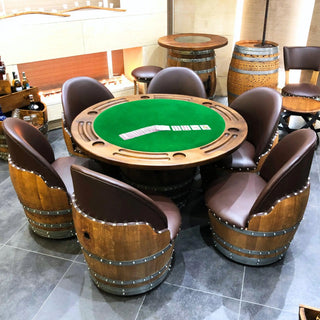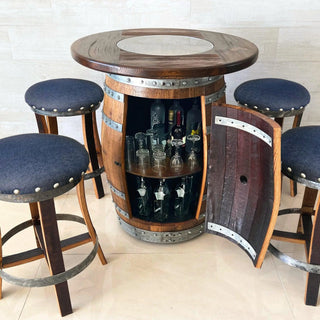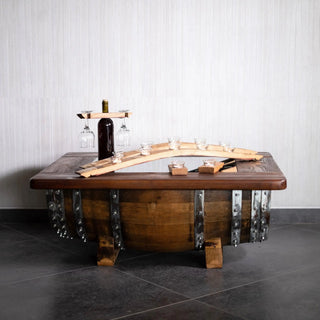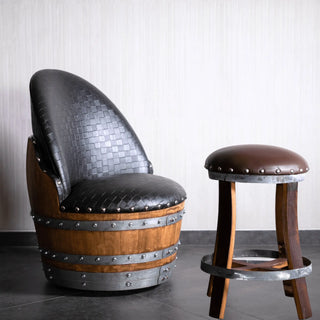The Process Behind Creating Authentic Engraved Barrel Tops
There’s a reason people stop and stare when they see a real oak barrel top hanging on a wall. It’s not just beautiful — it feels alive. The smell of the wood, the faint hint of old wine or bourbon soaked deep into the grain, the weight that tells you, “this thing has lived a life.”
If you’ve ever run your fingers over the carved lettering of an engraved barrel top — really felt it — you know it’s different from anything you’ll find in a department store. It’s got warmth, soul, and a kind of quiet honesty that only comes from something made slowly, by hand, from something that already has history.
Let’s take a walk through how these pieces come to life — from dusty cellars to your living room wall — the Oak Wood Wine Barrels way.
Step 1: Finding the Barrel with a Story to Tell
It all starts with the hunt.
We’re not looking for fresh-cut oak from a lumberyard. Nope. We want the ones that have lived — the barrels that have spent years aging wine, whiskey, or bourbon in the dark corners of a cellar somewhere. The ones that carry that unmistakable aroma of oak and spirit, with a patina that only time can paint.
Some have deep red stains from old Cabernet. Others have dark, smoky char from bourbon aging. You can see where the hoops once pressed into the wood, leaving perfect little scars of their journey.
When we find a barrel that feels right, there’s this weird kind of respect that kicks in. You’re not just salvaging wood — you’re saving history.
Step 2: Breaking Down the Barrel — Gently
Taking a barrel apart isn’t just woodworking — it’s almost emotional.
You don’t hack away at it. You take your time. Each stave (those curved oak planks) is loosened carefully, one by one. The metal hoops come off, the head — the barrel top — gets lifted like the lid of a time capsule.
Some heads come off clean. Others need repair, but we never overdo it. The goal is to restore, not erase. Every dent and stain tells a story, and we’re here to keep that story visible.
If you’ve ever seen the inside of one of these barrels, it’s stunning — darker, smoother, and slightly sweet to the nose. That’s decades of spirit, smoke, and oak bonding together. It’s poetry in wood form.
Step 3: Cleaning and Sanding — Bringing the Oak Back to Life
This is the moment the transformation begins.
Each barrel head gets cleaned by hand. No harsh chemicals. Just good old-fashioned care — soft brushes, natural oils, and patience.
Then comes the sanding. It’s not about making the surface flawless; it’s about making it honest. We smooth it just enough to prepare it for engraving, but we leave the soul intact. You’ll still see faint traces of the wine that once lived there, or the subtle dark lines where the barrel hoops pressed in.
Once sanded, the oak takes on a soft glow — golden in the light, still rugged in the shadows. It’s the kind of texture that begs to be touched.
Step 4: Designing the Engraving — Every Mark Has Meaning
This is my favorite part — the storytelling phase.
Each engraving starts with a blank circle of oak and a question: What story are we going to tell this time?
Maybe it’s a family name — “The Williams Cellar.” Maybe it’s a bar logo, a wedding date, or a cheeky phrase like “Aged to Perfection.” Whatever it is, it’s personal.
The design is mapped out digitally to fit the curve of the barrel top perfectly — but the feel of it stays old-world. Our designers understand the shape of the wood, how the grain might flow through a letter, how deep the engraving should be to make it look timeless, not flashy.
And then, the magic begins.
Step 5: Engraving — Where Fire Meets Oak
There’s a smell that hits you the moment the engraving starts — warm, sweet, a little smoky. That’s the scent of real oak meeting heat.
A laser slowly carves the design into the wood, one line at a time. You can literally watch it happen — the light dances across the surface, burning the letters in with the precision of a calligrapher and the patience of an artist.
Some pieces get darker, deeper burns for contrast; others keep a soft, golden finish. It depends on the personality of the wood. And make no mistake — every piece of oak has a personality.
By the time the laser is done, you’re staring at something that feels ancient and new all at once.
Step 6: Finishing and Sealing — Locking in the Beauty
Once the engraving’s done, it’s time to protect it — not smother it.
We use premium finishes that deepen the oak’s tone and bring out every grain, without drowning it in gloss. The finish is more of a whisper than a mask — enough to protect, but never to hide.
If the piece is meant for outdoor use, it gets a special weatherproof coat. These things are meant to last — to hang on porches, patios, bars, and homes for generations.
And when the seal dries? That’s when the oak really shines. It’s like it exhales and says, “I’m ready.”
Step 7: The Final Touch — A Craftsman’s Hand and a Quiet Moment
Before any piece leaves the workshop, someone — not a machine, a person — runs their hand across the engraving. They check the edges, the texture, the finish. They look for the small imperfections that make it real.
Sometimes they stop for a moment — not to fix anything, but just to admire it. Because after all that work, what they’re holding isn’t just wood anymore. It’s a story.
That last touch matters. It’s a kind of thank-you — from the craftsman to the oak, for sticking around long enough to tell another tale.
The Difference: Real vs. Replica
If you’ve ever picked up a fake “barrel top” from a big-box store, you know how light it feels. Hollow. Too smooth. Too perfect.
Real reclaimed oak has weight — physical and emotional. It’s uneven, unpredictable, and honest.
When you buy an authentic engraved barrel top from Oak Wood Wine Barrels, you’re not buying décor. You’re buying heritage. You’re hanging a piece of history that’s been touched by time, flame, and human hands.
It’s the kind of art you don’t just look at — you feel it.
Why Oak Wood Wine Barrels Pieces Are So Special
The team at Oak Wood Wine Barrels doesn’t just build things; they revive them. Each barrel top starts as a forgotten piece of cooperage and ends up as a one-of-a-kind work of art.
They don’t hide the imperfections — they highlight them. Every scratch, every mark, every hint of old wine is a badge of honor.
And when you hang one of their engraved barrel tops on your wall, you’re not just decorating — you’re giving history a second home.
Our Links
- Shop Custom Engraved Barrel Tops
- Explore Barrel Wall Décor & Heritage Pieces
- Learn More About Reclaimed Oak Craftsmanship
Other Resources Worth Exploring
- How Cooperage Became an Art Form — Wine Spectator
- Laser Artistry: The Fusion of Tech and Craft in Wood Engraving — Woodworker’s Journal
- The Beauty of Imperfection: Why Reclaimed Oak Feels So Alive — House Beautiful
⚠️ Disclaimer
This story isn’t written by a robot or some faceless brand. It’s written by someone who’s stood in a sawdust-filled workshop, watching a barrel head glow as it’s engraved — that faint crackle of heat meeting history.
Every piece from Oak Wood Wine Barrels is made from genuine, reclaimed oak — real barrels that aged real spirits. No replicas. No shortcuts. Just wood, time, and hands that care.
Each top will look a little different. That’s how you know it’s real.
For current designs, engraving options, and finishes, visit OBARREL.COM.
And when yours arrives — before you hang it — take a second. Run your palm over the grain. Breathe in that scent of oak and smoke.
You’re holding more than décor. You’re holding a memory — carved, sealed, and brought back to life.




